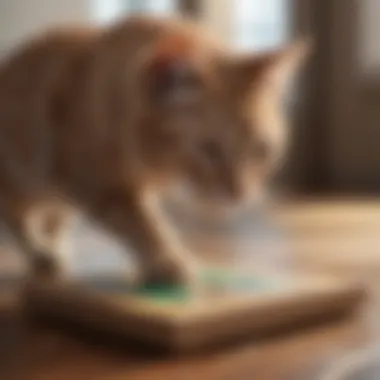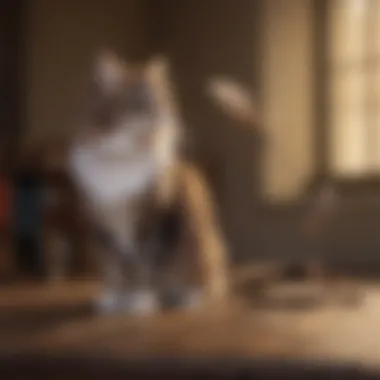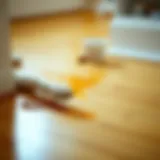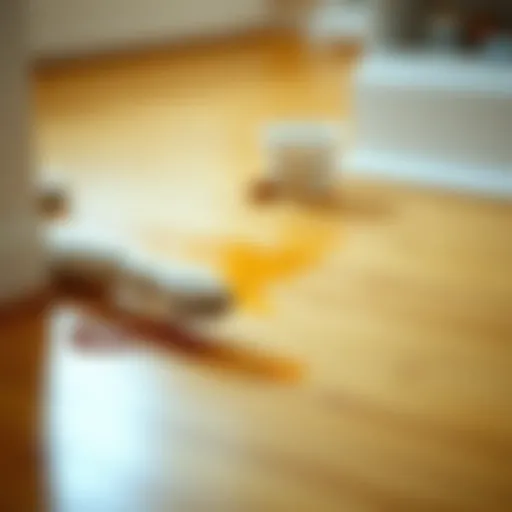Top Cat Toys That Encourage Independent Playtime


Intro
Cats are naturally curious creatures who require stimulating activities to thrive. Independent play is particularly important, as it helps felines hone their instincts and offer vast mental stimulation. Choosing the right toys can greatly enhance their play experience and keep them entertained.
This article will delve into essential cat toys that promote independent play. We will explore various categories of toys that suit different play styles and preferences. Understanding the types of materials used, safety considerations, and notable features will guide cat owners in selecting the ideal toys for their pets.
For many cats, independent play minimizes the need for constant human engagement, allowing them to explore their environment and satisfy their hunting instincts. Properly chosen toys fulfill a cat's desire to chase, pounce, and simulate real-life hunting scenarios. Let’s get started in discovering these important aspects.
Foreword to Independent Play
The topic of independent play for cats is crucial for both feline well-being and owner convenience. Unlike dogs, cats typically prefer solitary activities and have unique play behaviors. Understanding these behaviors can help cat owners facilitate a nurturing environment that meets their pet's needs. The essence of independent play isn't merely about providing toys; it involves recognizing cats' instinctual urges and allowing them the freedom to explore and engage on their own terms.
Understanding Feline Play Behavior
Feline play behavior reflects a blend of instinct, curiosity, and social interaction. Cats often engage in play that mimics hunting. They stalk, pounce, and capture. This natural instinct is not only for physical exercise but also serves as mental stimulation. Toys that resemble prey, such as the movements of a mouse or a fluttering insect, can harness this behavior. Cats demonstrate two primary play techniques: active play, which includes chasing and capturing, and manipulative play, where they bat and paw at objects. By recognizing these patterns, owners can select toys that align more closely with their cats' preferences.
The Importance of Self-Directed Activities
Self-directed play activities foster a sense of independence in cats. This is particularly important for indoor cats who may not have the same opportunities to explore their environment as outdoor cats do. Such activities are beneficial for their mental health, preventing boredom and reducing anxiety. A well-chosen toy can engage a cat for an extended period, allowing it to expend energy and satisfy its curiosity. It also frees owners from the responsibility of constant supervision during playtime. In this way, self-directed activities not only enhance cats' quality of life but also promote a balanced relationship between pets and their owners.
Criteria for Selecting Cat Toys
When choosing toys for your cat, certain criteria play a pivotal role in ensuring their suitability and effectiveness. Understanding these criteria helps cat owners make informed decisions that not only entertain their pets but also cater to their emotional and physical well-being.
Safety Standards and Non-Toxic Materials
First and foremost, the safety of cat toys cannot be overstated. Toys that are made from non-toxic materials ensure that your cat is not exposed to harmful substances during play. Look for toys that use organic fabrics, non-toxic plastics, and natural fibers. Some brands prioritize these materials, making it easier for you to select safe options. Always check for any choking hazards, as small parts can pose a risk for your cat. Various standards exist, such as the American Society for Testing and Materials (ASTM) guidelines, which provide benchmarks for safety.
Durability and Maintenance Considerations
The durability of cat toys is another essential criterion. Cats can be vigorous players, so toys must withstand the test of time and claws. Investing in high-quality toys can save money in the long run. Look for sturdy construction and check reviews regarding longevity. Maintenance is also crucial; choosing toys that are easy to clean helps to keep your cat’s playtime hygienic. Some materials allow for washing in a machine, while others may require handwashing. Regular inspection of toys for wear and tear can prevent potential hazards.
Engagement Factor: How Cats Interact with Toys
Understanding how cats interact with toys is vital. The best toys not only engage your cat physically but also mentally. Cats thrive on stimulation. Toys that provide varying levels of difficulties can ensure prolonged interest. Interactive toys, for instance, allow cats to engage in hunting behaviors. They can tap, paw, or chase these toys, mimicking their natural instincts. Watching your cat interact with a toy can give insights into their preferences, which can guide future purchases. Remember, the goal is to keep your cat entertained and mentally stimulated, promoting independence and joy in play.
Effective cat toys can mirror a cat's natural instincts and provide the necessary stimulation that promotes both physical and mental well-being.
Types of Cat Toys for Independent Play
Understanding the types of toys available for independent cat play is crucial for feline well-being. Independent play allows cats to engage their instincts and relieve stress. The right toys can keep them entertained and mentally stimulated without the need for constant human interaction. Each category of toy serves different needs, whether it is for physical exercise or mental engagement. Selecting suitable toys contributes significantly to a happier, healthier cat.
Interactive Toys: Solo Fun
Overview of Automatic Feeders


Automatic feeders stand out as a convenient tool for maintaining a cat’s feeding schedule, while also facilitating independent play. They provide food at set intervals, which encourages cats to explore and engage with their environment. This interaction can prevent boredom, making them a popular choice among pet owners. A key characteristic of automatic feeders is their ability to dispense food or treats without human oversight. This not only keeps cats physically active as they wait and respond to feeding but also satisfies their natural foraging instincts.
However, it is essential to select a feeder made from safe materials to ensure your cat's health. An advantage of automatic feeders is that they can be programmed for portion control, helping to manage your cat's diet. On the downside, some models might be complex in setting up or could malfunction, leading to confusion or frustration for your pet.
Self-Playing Laser Toys
Self-playing laser toys offer a unique entertainment experience for cats. These devices project a laser dot for cats to chase, simulating prey behavior. Cats find this type of play intriguing, stimulating both their physical and mental faculties. A hallmark of self-playing laser toys is their automatic engagement feature, which keeps pets active without the owner needing to be present.
While self-playing laser toys are popular for their entertainment value, they do raise a few concerns. Cats may not catch the elusive dot, which can lead to frustration. It is important to balance this type of play with physical toys to ensure a well-rounded play experience.
Puzzle Toys: Mental Stimulation
Features of Puzzle Feeders
Puzzle feeders are designed to challenge a cat’s problem-solving abilities. They require the cat to work for their food by solving a puzzle, promoting mental stimulation and engagement. The standout aspect of puzzle feeders is that they combine playtime with mealtime, making feeding a fun challenge. This active pursuit prevents rapid eating and helps maintain a healthier digestive system.
Another benefit is their adaptability; many puzzle feeders come in various difficulty levels, catering to both novice and skilled pets. However, they may frustrate some cats if the challenge is too high, leading to disinterest. Properly assessing your cat’s ability is key in choosing the right puzzle feeder.
Types of Psychological Engagement
Different types of psychological engagement through toys can significantly enhance a cat's play experience. Engaging toys can mimic hunting and foraging behaviors, which are crucial for a cat’s mental health. These toys activate curiosity and intelligence, encouraging independence.
One such characteristic is interactive features, like sounds or treats that reward exploration. These stimulants can hold a cat’s attention longer than standard toys. On the downside, a lack of variety in stimulation can lead smart cats to lose interest quickly, necessitating regular rotation of toys to maintain excitement.
Balls and Throws: Classic Appeal
Materials and Bounce
Ball toys are a timeless choice for feline play. They can be made from rubber, plastic, or fabric, and the bounce factor is vital in creating excitement. A well-designed ball that bounces unpredictably encourages cats to engage in play, fostering physical activity. The classic appeal of balls rests in their simplicity and ability to mimic the movement of prey.
Choosing the right material can enhance safety and durability. Some cats may enjoy softer balls that are gentle on their teeth. However, a downside is that lightweight balls can become easily lost under furniture, necessitating frequent retrieval.
Various Surface Textures
Surface textures on ball toys can affect a cat's interest and comfort. Textured surfaces may intrigue cats, encouraging them to explore different ways of interacting with their toys. For example, a ball with a fuzzy cover might be appealing to cats who enjoy tactile feedback.
The benefit of varying surface textures lies in the multifaceted engagement it offers to pets. However, if textures are too rough, they can potentially cause discomfort or injury during play.
Catnip and Herbal Toys: Natural Engagement
Effects of Catnip
Catnip has long been known to elicit playful and euphoric responses in many cats. Its effects can lead to heightened interest in toys, making catnip-infused toys exceptionally engaging. A key aspect of catnip toys is that they encourage cats to play actively and stimulate their natural hunting instincts.
The main advantage of these toys is their natural appeal, as they can provide hours of fun. However, not all cats respond to catnip, limiting its effectiveness for some individuals. This variability can impact the overall success of using these types of toys.


Alternative Herbal Toys
For those cats that do not react to catnip, alternative herbal toys can also be beneficial. These may contain valerian or silver vine, which some cats find just as enticing. The main advantage is the ability to cater to a broader range of feline preferences, ensuring every cat can find something stimulating.
However, similar to catnip, the effects can vary greatly between individual cats, making it essential to know your pet’s likes and dislikes.
String and Wand Toys: A Different Approach
Transitioning to Independent Play
String and wand toys are primarily designed for interactive play between a human and a cat. However, transitioning these toys into independent play can be done effectively with some planning. These toys create a natural prey-like experience, and when left in a safe area, they can spur cats to engage in solo play.
One of the best elements of this transition is the way these toys continue to inspire movement. By giving cats the chance to explore the toy alone, owners can keep them occupied without constant supervision. Still, it's important to assess your cat's play style to ensure that they are not over-stimulated.
Safety Considerations
Safety is paramount when choosing any toy for independent play. Strings and wands can pose risks of entanglement, which necessitates careful supervision and management. Ensuring that toys are free from small parts that could be swallowed is another consideration. The key characteristic here is to routinely check toys for wear and tear, which can pose safety concerns.
Although these toys can provide extensive play value, there is a need for constant vigilance regarding their condition to prevent any accidents.
DIY Cat Toys for Personalized Engagement
Creating DIY cat toys can be an enjoyable and rewarding experience for both cats and their owners. These personalized toys cater to individual feline preferences and are often crafted with available materials at home. From an emotional aspect, engaging in this creative process can enhance the bond between the owner and the pet, fostering a positive environment for both parties.
Moreover, DIY toys typically involve minimal cost and allow for customization. This approach ensures that cats receive toys that truly meet their specific play behaviors. Different cats have unique likes and dislikes; thus, creating toys at home allows for greater flexibility in design and materials. Additionally, crafting toys provides the assurance that the pet is engaging with safe and non-toxic substances.
Crafting Interactive Toys at Home
When crafting interactive toys, consider incorporating elements that stimulate a cat's natural instincts. Here are some ideas to explore:
- Tunnels: Use cardboard boxes or fabric to create tunnels that encourage exploration. Cats enjoy hiding and pouncing, and a tunnel can provide a sense of security while offering a fun play experience.
- Wand Toys: Attach feathers or strings to a stick. This type of toy can mimic prey movement, encouraging active play and engaging the cat’s hunting instincts.
- Ball Toys: Make balls from crumpled paper or rolled-up socks. Cats like to bat these around, mimicking prey dynamics.
- Homemade Crinkle Toys: Add crinkly sounds to toys by placing aluminum foil inside a fabric pouch. The sound captures a cat’s attention effectively.
Care must be taken when making toys; always supervise your cat to prevent them from ingesting small pieces.
Using Common Household Items
Household items can be transformed into engaging toys with a bit of creativity. Below are some common items that can serve as the basis for DIY cat toys:
- Toilet Paper Tubes: Cut the tubes into different lengths to create appealing structures for your cat to explore. You can even stuff them with treats for added interest.
- Sock Stuffers: Old socks can be filled with catnip or crumpled paper and tied off securely. This makes for a soft, interactive toy.
- Plastic Bottle Caps: These small items can roll, creating a fun chasing game that cats often enjoy. Ensure the caps are cleaned and safe for play.
- String and Yarn: Use with caution; while cats love to chase and bat at string, it can pose a choking hazard if ingested. Always supervise playtime with such items.
In summary, DIY cat toys offer a multitude of benefits, including customization and cost-effectiveness. By using common materials at home, owners can create engaging toys that pique their cat's interest and promote independent play. Not only does this enrich the feline's environment, but it also strengthens the human-animal bond.
The Role of Environment in Play
Understanding how the environment affects a cat's play is crucial for ensuring their well-being. The physical space where a cat plays can significantly influence their engagement with toys. Cats are inherently territorial, and having a defined, safe area for play can enhance their comfort and stimulation. An enriched environment allows a cat to explore, hunt, and engage in behaviors that align with their natural instincts. Therefore, optimizing their surroundings can lead to more fulfilling independent play.


Creating Safe Play Areas
The foundation of a productive play environment starts with safety. It's vital to establish a dedicated space for play, ensuring that there are no potential hazards that could harm your cat. This could involve:
- Removing toxic plants: Some common household plants can be harmful to cats, so always ensure these are out of reach.
- Clearing clutter: Toys, string, and small objects can pose choking hazards. A tidy space is essential for safe exploration.
- Supervising initially: Especially with new toys, monitor your cat to see how they interact and if there are any concerns with the environment.
Providing various surfaces and spots for play also encourages physical engagement. Cats often enjoy different textures on the floor, such as carpets, tiles, or even cat trees, as they serve multiple purposes in their play. A safe area not only enhances the fun but also allows the feline to express their natural behaviors, promoting happiness and confidence.
Incorporating Vertical Space
Cats are natural climbers and often find security and intrigue in elevated spaces. Incorporating vertical elements into their play area can stimulate independent action. This includes:
- Cat trees: These structures provide multiple levels for climbing and resting, enticing cats to engage actively.
- Wall shelves: Creating shelves that allow your cat to jump and perch can mimic their instinctual need to explore heights.
- Hanging toys: Suspend toys from higher points for your cat to pounce and interact with, adding another layer of challenge and engagement in their play.
By integrating vertical space, you cater to the climbing habits of your feline, encouraging healthy exercise and activity. A cat-friendly environment should seamlessly blend horizontal and vertical opportunities to play, enabling the cat to utilize their environment fully and independently. Whether it's scratching, climbing, or exploring, a stimulating environment promotes not only play but also overall well-being.
Evaluating Effectiveness of Toys
Evaluating the effectiveness of cat toys plays a critical role in ensuring that our feline companions remain engaged and stimulated through independent play. Understanding how a toy facilitates this engagement helps cat owners select products that genuinely resonate with their pet's interests. Proper evaluation can lead to improved mental health and satisfaction for cats, while also helping owners feel reassured that they are providing enriching experiences.
There are several specific elements to consider when assessing the effectiveness of toys:
- Engagement Duration: How long does a cat stay interested? Effective toys capture a cat's attention for extended periods. Monitoring the time spent interacting with a toy can provide clear insights into its appeal.
- Variety in Interaction: Different cats have different play styles. Some prefer chasing, while others like pouncing or batting. An effective toy usually caters to various types of interactions, providing diverse usage scenarios.
- Physical and Mental Stimulation: Toys that challenge a cat intellectually or encourage physical activity are more likely to be effective. Puzzle toys or those requiring manipulation to release treats can keep cats both mentally and physically engaged.
In addition, determining effectiveness involves reassessing toys after a period of use. Factors such as wear and tear or changes in a cat's preferences can influence engagement levels over time.
Monitoring Engagement Levels
Monitoring how your cat interacts with toys falls under an acrtive role an owner can take to ensure their pet's needs are met. It's essential to observe not only the duration of play but also how the cat interacts with different toys. Does your cat immediately engage, or does it shy away? Is there excitement or boredom?
- Behavioral Signs: Look for signs of enthusiasm such as rapid movement or vocalizations. If your cat seems disinterested, it may signal that the toy isn't sufficient for its needs.
- Repeated Use: If the toy quickly loses its allure, it may not be the best choice. Effective toys should maintain their appeal over time, perhaps requiring occasional rotation with other toys to keep the playtime fresh.
Logging these observations can aid in understanding what specific elements resonate with your cat and help refine choices in future toy purchases.
Adjusting Play Options Based on Behavior
As an owner, adapting to your cat's evolving preferences is vital for maintaining engaging play opportunities. Cats can change their interests much like humans can, and staying attuned to these shifts is crucial.
- Response to New Toys: Introducing new toys can breathe life into a play routine. Keep an eye on your cat's response to newly introduced toys compared to older ones. If a new toy sparks immediate interest, consider integrating such types more frequently.
- Weaning Out Disinterest: If a particular toy is met with disinterest, it may be time to replace it. Don't hesitate to remove toys that do not serve their intended purpose.
- Observing Play Patterns: Watch for trends in your cat’s play behavior. For instance, if your cat gravitates towards puzzle or challenge-based toys, you might consider investing more into those categories.
Finale
In this article, we explored the significance of selecting the right cat toys for fostering independent play. This topic provides invaluable insights for cat owners seeking to enrich their pets' lives while allowing them autonomy. One of the core elements is recognizing that cats thrive on mental and physical stimulation. When provided with engaging toys, they can entertain themselves, which not only leads to happy pets but also benefits their owners who may have busy schedules.
Recap of Key Points
- Understanding Feline Play Behavior: Cats engage differently in play depending on their personality. Recognizing these traits can aid in choosing toys that cater to individual preferences.
- Safety and Durability: Opting for toys made from non-toxic materials ensures safety. Moreover, durable constructions mean prolonged use without easy wear and tear.
- Various Toy Types: We've discussed several categories, such as interactive and puzzle toys, which provide mental challenges. Balls and herbal toys were also emphasized for their classic appeal and natural allure.
- DIY Options: Crafting personalized toys from household items adds a unique touch, making play more special for the cat.
- Monitoring Engagement: It's crucial to assess how cats interact with toys, allowing adjustments to be made based on their behavior and interests.
Final Thoughts on Feline Independence
Ultimately, fostering independence in cats is beneficial on multiple levels. By allowing them the freedom to play alone, owners contribute to their mental health and well-being. Not only does independent playkeep cats engaged and active, it also reduces the constant need for supervision, which can be a relief for busy owners.
Investing time in researching and selecting the right toys can lead to lasting benefits. In the end, ensuring your cat's happiness and health through empowering solo play is a worthwhile pursuit. The right toys can enrich their life, enhance their play experience, and provide satisfaction for you as an owner.















